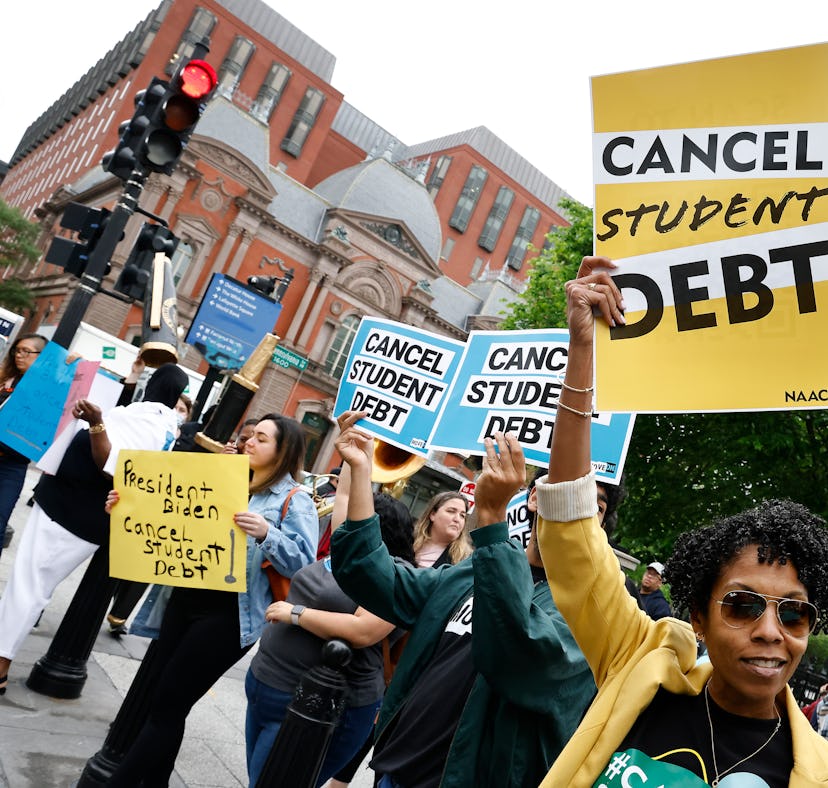
Student Debt Cancellation Is FINALLY Happening, & Here’s How To Get It
There’s a party in my loan account and everyone’s invited!
With the freeze on federal student loan payments expected to end on Dec. 31, 2022, people all over the country have been waiting on President Joe Biden to make good on his campaign promise to cancel federal student loan debt — and it looks like he is. On Oct. 17, the administration finally rolled out the official portal to allow people to apply for federal student debt relief — so here’s who’s eligible for up to $20,000 in debt cancellation, and how you can take advantage of this opportunity.
On Aug. 24, the White House announced a plan to forgive thousands of dollars of debt for millions of student loan borrowers. So, just how much can you get cancelled? Most federal borrowers can get up to $10,000 of student loan debt cancelled, with that number increasing to $20,000 if you received federal Pell grants. The president’s promise to cancel some $10,000 of student loan debt goes back years, to when he was on the campaign trail running to win the November 2020 election. “We should forgive a minimum of $10,000/person of federal student loans, as proposed by Senator [Elizabeth] Warren and colleagues,” Biden wrote in a March 2020 tweet. “Young people and other student debt holders bore the brunt of the last crisis. It shouldn't happen again.”
What’s in the relief plan?
According to The U.S. Department of Education (DOE), Biden’s debt relief rollout is a three-part plan designed to cut down current student debt, and prevent excessive student debt from accumulating in the future. The first part of the plan includes extending the student loan payment pause to Dec. 31, so payments aren’t projected to resume until January 2023. The second part of the plan includes “targeted debt relief to low- and middle-income families,” per the DOE, with some borrowers eligible to have all their debt forgiven through the Public Service Loan Forgiveness (PSLF) program. The third part of the plan includes changing the federal student loan system to make it “more manageable for current and future borrowers” by significantly reducing monthly payment requirements “for lower- and middle-income borrowers.”
And of course, the biggest part — cancelling debt for people who already owe on student loans. The announcement would cancel up to $10,000 of federal loan debt (sorry, you can’t cancel more than you owe) for people making up to a certain income level, and then another $10,000 on top of that if you got Pell grants.
Who is eligible?
Relief will be available to individuals earning $125,000 a year or less, or households earning $250,000 a year or less. However, the White House projects that around 90% of the plan’s benefits will go to households earning less than $75,000 a year, according to a fact sheet shared by the White House.
The benefits will cover debt accrued during both graduate and undergraduate studies, per NBC News. The benefits will also not be counted as taxable income due to a provision included in Biden’s January 2021 American Rescue Plan.
How to get it:
The portal to apply for debt cancellation officially launched at studentaid.gov on Monday, Oct. 17, after a brief beta test over the preceding weekend. Available in English or Spanish, it’s pleasantly simple — applicants fill out their name and contact, as well as identifying information such as social security number and date of birth, and sign to confirm their eligibility under the program’s requirements. But it’s important to note that, per the portal, applications must be submitted by Dec. 31, 2023. According to the White House, around 8 million people applied for relief under the beta version of the portal.
“As millions of people fill out the application, we’re going to make sure the system continues to work as smoothly as possible so that we can deliver student loan relief for millions of Americans as quickly and as efficiently as possible,” President Joe Biden said in Oct. 17 remarks.
While this clearly an unprecedented move, people all over the country are still calling for more debt cancellation. According to several Democratic lawmakers and progressive groups, like the American Civil Liberties Union (ACLU), just beginning to address racial disparities within the student loan crisis would require forgiving $50,000 of debt.
While it’s unclear how big of a dent Biden’s plan will put in the country’s pervasive student loan crisis, one thing is certain — as long as obtaining a higher education in the United States is as costly as it is now, the debt will continue to mount.
This article was originally published on